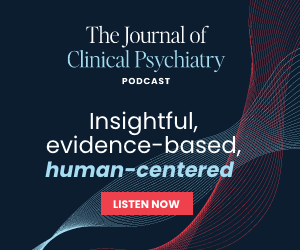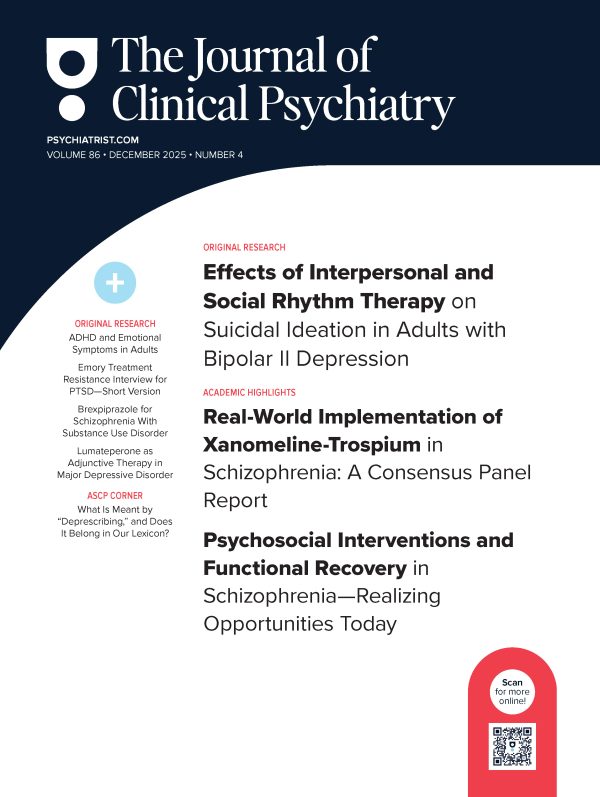![]()
ABSTRACT
Objective: A wealth of evidence has supported the efficacy of motivational interviewing (MI) in reducing substance use as well as other addictive behaviors. In view of the common co-occurrence of substance use disorder among individuals with schizophrenia spectrum disorders, there has been increased attention to applying MI in psychological interventions for individuals with co-occurring psychosis and substance use disorder. This review aims to synthesize the evidence on the efficacy of MI interventions (either as a stand-alone intervention or in combination with other psychological interventions) in reducing substance use and psychotic symptoms.
Data Sources: MEDLINE, PsycINFO, EMBASE, CENTRAL, and CINAHL were searched using keywords related to “psychosis,” “substance addiction,” and “motivational interviewing” to identify studies published in English from 1984 to May 2021.
Study Selection: Of 1,134 articles identified in the literature, we selected 17 studies for review: 5 studies examined stand-alone MI (“MI-pure”), and 13 studies assessed MI as a major treatment component (“MI-mixed”).
Data Extraction: Demographics of participants, intervention characteristics, and outcome data were extracted by the first author and checked by the second author. Random-effects models were used for substance use and psychotic symptom outcomes.
Results: MI-pure interventions did not significantly reduce severity of substance use (g = 0.06, P = .81) or psychotic symptoms (g’s for 2 individual studies = 0.16, P = .54; and 0.01, P = .96). The effect of MI-mixed interventions on substance use decrease was statistically significant but small in size (g = 0.15, P = .048), whereas the effect on psychotic symptom improvement was not significant (g = 0.11, P = .22).
Conclusions: With the caveat that only a small number of comparisons were available for the review on MI-pure interventions, the efficacy of MI in treating co-occurring psychosis and substance use disorder was heterogeneous and modest.
Members Only Content
This full article is available exclusively to Professional tier members. Subscribe now to unlock the HTML version and gain unlimited access to our entire library plus all PDFs. If you’re already a subscriber, please log in below to continue reading.
References (75)

- Sara GE, Burgess PM, Malhi GS, et al. Stimulant and other substance use disorders in schizophrenia: prevalence, correlates and impacts in a population sample. Aust N Z J Psychiatry. 2014;48(11):1036–1047. PubMed CrossRef
- Brunette MF, Mueser KT, Babbin S, et al. Demographic and clinical correlates of substance use disorders in first episode psychosis. Schizophr Res. 2018;194:4–12. PubMed CrossRef
- Hunt GE, Large MM, Cleary M, et al. Prevalence of comorbid substance use in schizophrenia spectrum disorders in community and clinical settings, 1990–2017: Systematic review and meta-analysis. Drug Alcohol Depend. 2018;191:234–258. PubMed CrossRef
- Barrowclough C, Haddock G, Fitzsimmons M, et al. Treatment development for psychosis and co-occurring substance misuse: a descriptive review. J Ment Health. 2006;15(6):619–632. CrossRef
- Grech A, Van Os J, Jones PB, et al. Cannabis use and outcome of recent onset psychosis. Eur Psychiatry. 2005;20(4):349–353. PubMed CrossRef
- van Os J, Bak M, Hanssen M, et al. Cannabis use and psychosis: a longitudinal population-based study. Am J Epidemiol. 2002;156(4):319–327. PubMed CrossRef
- Dom G, Moggi F. Co-occurring Addictive and Psychiatric Disorders. Springer Berlin Heidelberg; 2015.
- Lehman AF, Lieberman JA, Dixon LB, et al; American Psychiatric Association; Steering Committee on Practice Guidelines. Practice guideline for the treatment of patients with schizophrenia, second edition. Am J Psychiatry. 2004;161(suppl):1–56. PubMed
- National Institute for Health and Care Excellence. Psychosis and Schizophrenia in Adults: Prevention and Management (NICE Clinical Guideline No. 178). National Institute for Health and Care Excellence website. https://www.nice.org.uk/guidance/cg178. 2014.
- Kumari V, Postma P. Nicotine use in schizophrenia: the self medication hypotheses. Neurosci Biobehav Rev. 2005;29(6):1021–1034. PubMed CrossRef
- Fiorentini A, Volonteri LS, Dragogna F, et al. Substance-induced psychoses: a critical review of the literature. Curr Drug Abuse Rev. 2011;4(4):228–240. PubMed CrossRef
- Bramness JG, Gundersen OH, Guterstam J, et al. Amphetamine-induced psychosis: a separate diagnostic entity or primary psychosis triggered in the vulnerable? BMC Psychiatry. 2012;12(1):221. PubMed CrossRef
- Martino S, Carroll K, Kostas D, et al. Dual Diagnosis Motivational Interviewing: a modification of Motivational Interviewing for substance-abusing patients with psychotic disorders. J Subst Abuse Treat. 2002;23(4):297–308. PubMed CrossRef
- National Institute for Health and Care Excellence. Coexisting Severe Mental Illness (Psychosis) and Substance Misuse: Assessment and Management in Healthcare Settings (NICE Clinical Guideline No. 120). National Institute for Health and Care Excellence website. https://www.nice.org.uk/guidance/cg120. 2011.
- Miller WR. Motivational interviewing with problem drinking. Behav Cogn Psychother. 1983;11(2):147–172. CrossRef
- Miller WR, Rollnick S. Motivational Interviewing: Helping People Change. 3rd ed. Guilford Press; 2013.
- Arkowitz H, Westra HA, Miller WR, et al. Motivational Interviewing in the Treatment of Psychological Problems. 2nd ed. Guilford Press; 2015.
- Lundahl BW, Kunz C, Brownell C, et al. A meta-analysis of motivational interviewing: twenty-five years of empirical studies. Res Soc Work Pract. 2010;20(2):137–160. CrossRef
- Burke BL, Arkowitz H, Menchola M. The efficacy of motivational interviewing: a meta-analysis of controlled clinical trials. J Consult Clin Psychol. 2003;71(5):843–861. PubMed CrossRef
- Hettema J, Steele J, Miller WR. Motivational interviewing. Annu Rev Clin Psychol. 2005;1(1):91–111. PubMed CrossRef
- Rubak S, Sandbaek A, Lauritzen T, et al. Motivational interviewing: a systematic review and meta-analysis. Br J Gen Pract. 2005;55(513):305–312. PubMed
- Vasilaki EI, Hosier SG, Cox WM. The efficacy of motivational interviewing as a brief intervention for excessive drinking: a meta-analytic review. Alcohol Alcohol. 2006;41(3):328–335. PubMed CrossRef
- Amrhein PC, Miller WR, Yahne CE, et al. Client commitment language during motivational interviewing predicts drug use outcomes. J Consult Clin Psychol. 2003;71(5):862–878. PubMed CrossRef
- Miller WR, Rose GS. Toward a theory of motivational interviewing. Am Psychol. 2009;64(6):527–537. PubMed CrossRef
- Miller WR, Rollnick S. Motivational Interviewing: Preparing People to Change. 2nd ed. Guilford Press; 2002.
- Graeber DA, Moyers TB, Griffith G, et al. A pilot study comparing motivational interviewing and an educational intervention in patients with schizophrenia and alcohol use disorders. Community Ment Health J. 2003;39(3):189–202. PubMed CrossRef
- Kemp R, Harris A, Vurel E, et al. Stop Using Stuff: trial of a drug and alcohol intervention for young people with comorbid mental illness and drug and alcohol problems. Australas Psychiatry. 2007;15(6):490–493. PubMed CrossRef
- Barrowclough C, Haddock G, Tarrier N, et al. Randomized controlled trial of motivational interviewing, cognitive behavior therapy, and family intervention for patients with comorbid schizophrenia and substance use disorders. Am J Psychiatry. 2001;158(10):1706–1713. PubMed CrossRef
- Cleary M, Hunt GE, Matheson S, et al. Psychosocial treatment programs for people with both severe mental illness and substance misuse. Schizophr Bull. 2008;34(2):226–228. PubMed CrossRef
- De Witte NA, Crunelle CL, Sabbe B, et al. Treatment for outpatients with comorbid schizophrenia and substance use disorders: a review. Eur Addict Res. 2014;20(3):105–114. PubMed CrossRef
- Hjorthøj C, Fohlmann A, Nordentoft M. Treatment of cannabis use disorders in people with schizophrenia spectrum disorders: a systematic review. Addict Behav. 2009;34(6-7):520–525. PubMed CrossRef
- Lubman DI, King JA, Castle DJ. Treating comorbid substance use disorders in schizophrenia. Int Rev Psychiatry. 2010;22(2):191–201. PubMed CrossRef
- Tsuang J, Fong TW. Treatment of patients with schizophrenia and substance abuse disorders. Curr Pharm Des. 2004;10(18):2249–2261. PubMed CrossRef
- Liberati A, Altman DG, Tetzlaff J, et al. The PRISMA statement for reporting systematic reviews and meta-analyses of studies that evaluate health care interventions: explanation and elaboration. J Clin Epidemiol. 2009;62(10):e1–e34. PubMed CrossRef
- Moher D, Liberati A, Tetzlaff J, et al; PRISMA Group. Preferred reporting items for systematic reviews and meta-analyses: the PRISMA statement. PLoS Med. 2009;6(7):e1000097. PubMed CrossRef
- Miller WR, Rollnick S. Motivational Interviewing: Preparing People to Change Addictive Behavior. Guilford Press; 1991.
- Borenstein M, Hedges LV, Higgins JP, et al. Comprehensive Meta-Analysis Version 2.0. Biostat Inc; 2005.
- Hedges LV. Distribution theory for Glass’s estimator of effect size and related estimators. J Educ Behav Stat. 1981;6(2):107–128. CrossRef
- Cohen J. Statistical Power Analyses for the Behavioral Sciences. 2nd ed. Routledge Academic; 1988.
- Borenstein MHL, Higgins JPT, Rothstein HR. Introduction to Meta-Analysis. John Wiley & Sons; 2009.
- Hozo SP, Djulbegovic B, Hozo I. Estimating the mean and variance from the median, range, and the size of a sample. BMC Med Res Methodol. 2005;5(1):13. PubMed CrossRef
- Kay SR, Fiszbein A, Opler LA. The Positive and Negative Syndrome Scale (PANSS) for schizophrenia. Schizophr Bull. 1987;13(2):261–276. PubMed CrossRef
- Overall JE, Gorham DR. The Brief Psychiatric Rating Scale. Psychol Rep. 1962;10(3):799–812. CrossRef
- Jauhar S, McKenna PJ, Radua J, et al. Cognitive-behavioural therapy for the symptoms of schizophrenia: systematic review and meta-analysis with examination of potential bias. Br J Psychiatry. 2014;204(1):20–29. PubMed CrossRef
- Dawe S, Mattick RP. Review of Diagnostic Screening Instruments for Alcohol and Other Drug Use and Other Psychiatric Disorders. Australian Government Publishing Service; 1997.
- Skinner HA. The Drug Abuse Screening Test. Addict Behav. 1982;7(4):363–371. PubMed CrossRef
- McLellan AT, Luborsky L, Woody GE, et al. An improved diagnostic evaluation instrument for substance abuse patients. The Addiction Severity Index. J Nerv Ment Dis. 1980;168(1):26–33. PubMed CrossRef
- Higgins JPT, Thompson SG, Deeks JJ, et al. Measuring inconsistency in meta-analyses. BMJ. 2003;327(7414):557–560. PubMed CrossRef
- Egger M, Davey Smith G, Schneider M, et al. Bias in meta-analysis detected by a simple, graphical test. BMJ. 1997;315(7109):629–634. PubMed CrossRef
- Duval S, Tweedie R. Trim and fill: a simple funnel-plot-based method of testing and adjusting for publication bias in meta-analysis. Biometrics. 2000;56(2):455–463. PubMed CrossRef
- Higgins JPT, Thomas J, Chandler J, et al. Cochrane Handbook for Systematic Reviews of Interventions. Version 6.2. Cochrane website. 2021. http://www.training.cochrane.org/handbook
- Tantirangsee N, Assanangkornchai S, Marsden J. Effects of a brief intervention for substance use on tobacco smoking and family relationship functioning in schizophrenia and related psychoses: a randomised controlled trial. J Subst Abuse Treat. 2015;51:30–37. PubMed CrossRef
- Kavanagh DJ, Young R, White A, et al. A brief motivational intervention for substance misuse in recent-onset psychosis. Drug Alcohol Rev. 2004;23(2):151–155. PubMed CrossRef
- Bonsack C, Gibellini Manetti S, Favrod J, et al. Motivational intervention to reduce cannabis use in young people with psychosis: a randomized controlled trial. Psychother Psychosom. 2011;80(5):287–297. PubMed CrossRef
- Brunette MF, Ferron JC, McGurk SR, et al. Brief, web-based interventions to motivate smokers with schizophrenia: randomized controlled trial. JMIR Ment Health. 2020;7(2):e16524. PubMed CrossRef
- Haddock G, Barrowclough C, Tarrier N, et al. Cognitive-behavioural therapy and motivational intervention for schizophrenia and substance misuse: 18-month outcomes of a randomised controlled trial. Br J Psychiatry. 2003;183(5):418–426. PubMed CrossRef
- James W, Preston NJ, Koh G, et al. A group intervention which assists patients with dual diagnosis reduce their drug use: a randomized controlled trial. Psychol Med. 2004;34(6):983–990. PubMed CrossRef
- Baker A, Bucci S, Lewin TJ, et al. Cognitive-behavioural therapy for substance use disorders in people with psychotic disorders: randomised controlled trial. Br J Psychiatry. 2006;188(5):439–448. PubMed CrossRef
- Johnson S, Thornicroft G, Afuwape S, et al. Effects of training community staff in interventions for substance misuse in dual diagnosis patients with psychosis (COMO study): cluster randomised trial. Br J Psychiatry. 2007;191(5):451–452. PubMed CrossRef
- Craig TKJ, Johnson S, McCrone P, et al. Integrated care for co-occurring disorders: psychiatric symptoms, social functioning, and service costs at 18 months. Psychiatr Serv. 2008;59(3):276–282. PubMed CrossRef
- Barrowclough C, Haddock G, Wykes T, et al. Integrated motivational interviewing and cognitive behavioural therapy for people with psychosis and comorbid substance misuse: randomised controlled trial. BMJ. 2010;24(341):c6325. PubMed CrossRef
- Williams JM, Steinberg ML, Zimmermann MH, et al. Comparison of two intensities of tobacco dependence counseling in schizophrenia and schizoaffective disorder. J Subst Abuse Treat. 2010;38(4):384–393. PubMed CrossRef
- Morrens M, Dewilde B, Sabbe B, et al. Treatment outcomes of an integrated residential programme for patients with schizophrenia and substance use disorder. Eur Addict Res. 2011;17(3):154–163. PubMed CrossRef
- Hjorthøj CR, Fohlmann A, Larsen AM, et al. Specialized psychosocial treatment plus treatment as usual (TAU) versus TAU for patients with cannabis use disorder and psychosis: the CapOpus randomized trial. Psychol Med. 2013;43(7):1499–1510. PubMed CrossRef
- Madigan K, Brennan D, Lawlor E, et al. A multi-center, randomized controlled trial of a group psychological intervention for psychosis with comorbid cannabis dependence over the early course of illness. Schizophr Res. 2013;143(1):138–142. PubMed CrossRef
- Barrowclough C, Marshall M, Gregg L, et al. A phase-specific psychological therapy for people with problematic cannabis use following a first episode of psychosis: a randomized controlled trial. Psychol Med. 2014;44(13):2749–2761. PubMed CrossRef
- Gouzoulis-Mayfrank E, König S, Koebke S, et al. Trans-sector integrated treatment in psychosis and addiction: a randomized controlled study of a motivational, cognitive behavioral therapy program under standard hospital treatment conditions. Dtsch Arztebl Int. 2015;112(41):683–691. PubMed
- Sobell LC, Sobell MB. Timeline follow-back. In: Litten RZ, Allen JP, eds. Measuring Alcohol Consumption: Psychosocial and Biochemical Methods. Humana Press; 1992:41–72.
- Darke S, Ward J, Hall W, et al. The Opiate Treatment Index (OTI) Manual. Technical Report Number 11. National Drug and Alcohol Research Centre; 1991.
- Andreasen NC. The Scale for Assessment of Positive Symptoms (SAPS). University of Iowa; 1984.
- Andreasen NC. The Scale for Assessment of Negative Symptoms (SANS). University of Iowa; 1983.
- Dumaine ML. Meta-analysis of interventions with co-occurring disorders of severe mental illness and substance abuse: implications for social work practice. Res Soc Work Pract. 2003;13(2):142–165. CrossRef
- Riper H, Andersson G, Hunter SB, et al. Treatment of comorbid alcohol use disorders and depression with cognitive-behavioural therapy and motivational interviewing: a meta-analysis. Addiction. 2014;109(3):394–406. PubMed CrossRef
- Baker AL, Hides L, Lubman DI. Treatment of cannabis use among people with psychotic or depressive disorders: a systematic review. J Clin Psychiatry. 2010;71(3):247–254. PubMed CrossRef
- Carney T, Myers B. Effectiveness of early interventions for substance-using adolescents: findings from a systematic review and meta-analysis. Subst Abuse Treat Prev Policy. 2012;7(1):25. PubMed CrossRef




